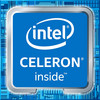Intel Celeron J3355 vs Intel Core i5-8200Y
Intel Celeron J3355
► remove from comparison
The Intel Celeron J3355 is a dual-core SoC primarily for inexpensive notebooks and was announced in late 2016. It runs at 2 - 2.5 GHz (Single Core Burst) and is based on the Apollo Lake platform. Similar to the Braswell predecessor, the chip is manufactured in a 14 nm process (P1273) with FinFETs. Besides two CPU cores, the chip also includes a DirectX 12 capable GPU as well as a DDR3L/LPDDR3/LPDDR4 memory controller (dual-channel, up to 1866/2400 MHz).
Architecture
For the first time in a couple of years, Intel completely reworked the CPU architecture of the Atom series. The manufacturer advertises performance gains of roughly 30 percent, but does not reveal any specifics about the individual changes. The new Goldmont architecture should therefore be roughly on par with AMD's Beema/Carrizo-L APUs in terms of per-MHz performance, but it still far behind the more expensive Core CPUs (like Skylake / Kaby Lake).
Performance
The CPU performance of the Celeron J3355 is slightly better than the lower power Celeron N3350 and less depending on the cooling solution. This means the processor is only suited for light daily tasks (office, browsing).
GPU Performance
The HD Graphics 500 (Apollo Lake) is based on Intel's Gen9 architecture, which supports DirectX 12 and is also used for the Kaby Lake / Skylake graphics adapters (like HD Graphics 520). Equipped with 12 EUs and a clock of up to 700 MHz, the performance should be roughly on par with the older HD Graphics (Braswell). This means only older and simpler titles will run smoothly.
The chip also includes an advanced video engine with hardware support for the playback of VP9 and H.265 material (8-bit color-depth).
Power Consumption
The Celeron J3355 is specified at 10 Watt TDP and therefore 4 Watts higher than the slightly slower Celeron N3350.
Intel Core i5-8200Y
► remove from comparisonThe Intel Core i5-8200Y is a very efficient dual-core SoC for tablets and passively cooled notebooks based on the Amber Lake generation and was announced on 28th August 2018. The CPU consists of two processor cores clocked at 1.3 - 3.9 GHz. Thanks to Hyper Threading, the processor can execute up to four threads simultaneously. The chips also includes the Intel HD Graphics 615 GPU, a dual-channel memory controller (DDR3L/LPDDR3) as well as VP9 and H.265 video de- and encoder. Compared to the Kaby Lake-Y predecessors (e.g. Core i7-7Y75), Amber Lake uses the same architecture produced in the improved 14nm+ FinFET process (no 14nm++) but offers higher clock speeds at an increased TDP rating.
Architecture
Intel basically used the familiar micro architecture from the Skylake / Kaby Lake generation, so the per-MHz performance is identical.
Performance
The performance of the Y series is highly depending on the cooling solution of the laptop / tablet and the TDP settings for sustained load. Therefore, the differences between a Core m3 and a i7 may be rather slim, if the thermals are very limited. The high Turbo clock speeds in Amber Lake should however lead to a very good single thread performance for short bursts.
Graphics
The integrated Intel HD Graphics 615 GPU has 24 Execution Units (EUs) like the old HD Graphics 515 and runs with clocks between 300 and 950 MHz in combination with this processor. The performance heavily depends on the TDP limit as well as the memory configuration; with fast LPDDR3-1866 RAM in dual-channel mode, the GPU should sometimes be able to compete with the HD Graphics 520, but can also be much slower in other scenarios. Modern games from 2016 will, if at all, only run smoothly in the lowest settings.
Contrary to Skylake, Kaby Lake and Amber Lake now also supports hardware decoding for H.265/HEVC Main10 with a 10-bit color depth as well as Google's VP9 codec.
Power Consumption
The chip is manufactured in the 14 nm+ process with FinFET transistors. The typical TDP for the Amber Lake Y-series is specified at 5 Watts (previous generations were 4.5 Watt), and can be adjusted in both directions depending on the usage scenario.
| Model | Intel Celeron J3355 | Intel Core i5-8200Y | ||||||||||||||||||||||||||||||||||||||||||||||||||||
| Codename | Apollo Lake | Amber Lake-Y | ||||||||||||||||||||||||||||||||||||||||||||||||||||
| Series | Intel Celeron | Intel Amber Lake | ||||||||||||||||||||||||||||||||||||||||||||||||||||
| Series: Amber Lake Amber Lake-Y |
|
| ||||||||||||||||||||||||||||||||||||||||||||||||||||
| Clock | 2000 - 2500 MHz | 1300 - 3900 MHz | ||||||||||||||||||||||||||||||||||||||||||||||||||||
| L2 Cache | 2 MB | 512 KB | ||||||||||||||||||||||||||||||||||||||||||||||||||||
| Cores / Threads | 2 / 2 | 2 / 4 | ||||||||||||||||||||||||||||||||||||||||||||||||||||
| TDP | 10 Watt | 5 Watt | ||||||||||||||||||||||||||||||||||||||||||||||||||||
| Technology | 14 nm | 14 nm | ||||||||||||||||||||||||||||||||||||||||||||||||||||
| max. Temp. | 105 °C | 100 °C | ||||||||||||||||||||||||||||||||||||||||||||||||||||
| Socket | FCBGA1296 | BGA | ||||||||||||||||||||||||||||||||||||||||||||||||||||
| Features | Intel HD Graphics 500 (12 EUs, 200 - 700 MHz), Quick Sync, AES-NI, max. 8 GB Dual-Channel DDR3L-1866/LPDDR3-1866/LPDDR4-2400 , 8x USB 3.0, 6x PCIe 2.0, 2x SATA 6.0 Gbit/s | Dual-Channel DDR3L-1600/LPDDR3-1866 Memory Controller, HyperThreading, AVX, AVX2, Quick Sync, Virtualization, AES-NI, vPro, TXT | ||||||||||||||||||||||||||||||||||||||||||||||||||||
| iGPU | Intel HD Graphics 500 (250 - 700 MHz) | Intel UHD Graphics 615 (300 - 950 MHz) | ||||||||||||||||||||||||||||||||||||||||||||||||||||
| Architecture | x86 | x86 | ||||||||||||||||||||||||||||||||||||||||||||||||||||
| $107 U.S. | ||||||||||||||||||||||||||||||||||||||||||||||||||||||
| Announced | ||||||||||||||||||||||||||||||||||||||||||||||||||||||
| Manufacturer | ark.intel.com | |||||||||||||||||||||||||||||||||||||||||||||||||||||
| L1 Cache | 128 KB | |||||||||||||||||||||||||||||||||||||||||||||||||||||
| L3 Cache | 4 MB |
Benchmarks
Average Benchmarks Intel Celeron J3355 → 100% n=2
Average Benchmarks Intel Core i5-8200Y → 294% n=2
* Smaller numbers mean a higher performance
1 This benchmark is not used for the average calculation













